VATICAN CITY (CNS) – At least three dozen women will be voting members of the assembly of the Synod of Bishops in October, Pope Francis has decided.
In a decision formalised on April 17, “the Holy Father approved the extension of participation in the synodal assembly to ‘non-bishops’ – priests, deacons, consecrated men and women, lay men and women,” the synod office said in a statement on April 26.
Cardinal Jean-Claude Hollerich, relator general of the synod, told reporters on April 26 that about 21 per cent of the synod’s 370 members would not be bishops, and at least half of that group would be women.
Adding women and young people to the membership will make sure “the Church is well represented” in the prayer and discussions scheduled for October 4-29 at the Vatican, the cardinal said.
Cardinal Mario Grech, synod secretary-general, told reporters, that “the Synod of Bishops will remain a synod of bishops”, but it will be “enriched” by representatives of the whole Church.
The Pope’s decision to expand the categories of synod members, the April statement said, “is in continuity” with the Catholic Church’s growing understanding of the synodal dimension of the Church and “the consequent understanding of the institutions through which it is exercised”.
Since the Synod of Bishops was reinstituted after the Second Vatican Council, the voting members of the synod have all been men. The membership was primarily cardinals and bishops, except for the 10 priests – and recently one religious brother – elected by the men’s Union of Superiors General.
Now, rather than the Union of Superiors General selecting 10 voting members, the office said, it will elect only five priests or brothers. And the women’s International Union of Superiors General also will elect five sisters or nuns.
Past synods have included women as non-voting “auditors”, a group that included many women.
Pope Francis has done away with the “auditor” category of synod participant, the Vatican said. Instead, there will be a group of 70 non-bishop members representing “various groupings of the faithful of the people of God”, including priests, consecrated women, deacons and laypeople from every part of the world.
The Pope will choose the 70 from a list of 140 people selected by bishops and organisers of six regional groupings of bishops – including Oceania – and by the Assembly of Patriarchs of Eastern Catholic Churches.
Each of the seven bishops’ groups will nominate 20 people, the statement said, and “it is requested that 50 per cent of them be women and that the presence of young people also be emphasised”.
In addition to the 10 religious elected by their groups of superiors and the 70 non-bishop members nominated by continental groups, Pope Francis may include “non-bishop members” among the members he appoints.
The leadership of the synod secretariat will also be full members.
Most synod members will be bishops elected by their episcopal conference or by their Eastern Catholic bishops’ synod. The number of delegates each conference can elect depends on the size of the conference.
Photo: Bishops and cardinals attend a session of the Synod of Bishops on the family at the Vatican in this Oct. 24, 2015, file photo. (CNS photo/Paul Haring)

It’s a beginning. Long long way to go. All the best to the voters.
The church is not a democracy. More votes does to equal a better church. In fact most likely a worse, watered down church. Holy Spirit, guide the Pope.